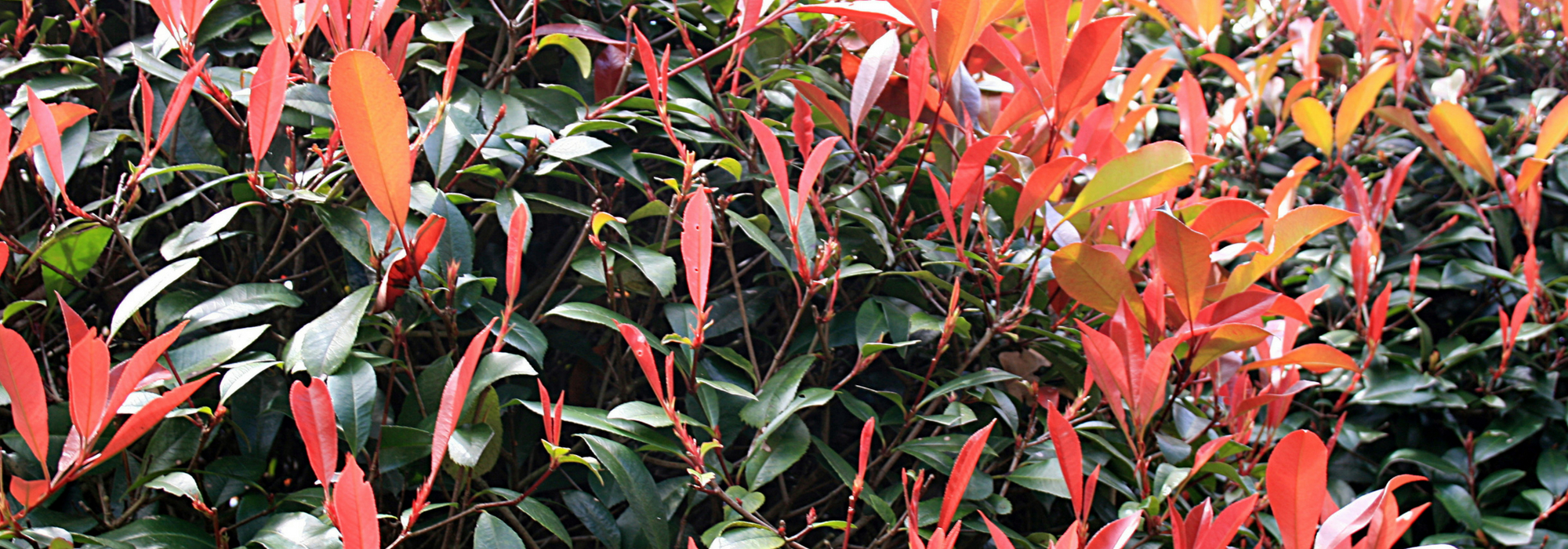
Photinia: planting, pruning and care
Contents
Photinia in a nutshell
- Photinias are evergreen bushes used in hedges and can also be used as standalone plants, in borders, or in pots.
- The most well-known variety, ‘Red Robin’, is often planted in hedges and is distinguished by its red foliage in spring.
- These bushes are very easy to care for, which explains their success throughout France.
- They prefer fresh, deep soil but tolerate drought and limestone quite well.
- Not demanding, they can be planted in full sun or partial shade.
A word from our expert
Photinia is a bush primarily used as a hedge plant due to the density of its large glossy leaves that emerge red or bronze in spring and with each regrowth following pruning. It also makes a lovely small ornamental tree with shiny foliage and a very graceful rounded habit. Simply remove the lower branches and clear the base of the main branches to highlight its branches. It adapts equally well to being shaped into topiary balls or columns, and grows very well in pots. Additionally, it has other advantages. The leaves turn scarlet in autumn while the frothy clusters of fragrant, melliferous white flowers adorn the branches in May-June if pruning is well-timed. Their growth is very rapid, around 50 to 60 cm per year from the second year of planting. They also tolerate 1 to 3 prunings per year, allowing for more frequent enjoyment of the colourful regrowth.

Beautiful umbel flowering of Photinia.
They easily form windbreaks, privacy screens, or low hedges depending on the vigour of the chosen varieties.
Feel free to try new cultivars such as P. serratifolia ‘Pink Crispy’ with its finely dentate bright pink young leaves or Photinia x fraseri ‘Carré Rouge’, which has the advantage of retaining the bright red colour of its latest shoots throughout the year. The latter are highlighted by the older bright green, finely serrated foliage, whose brilliance is accentuated by the undulations of the lamina. These specimens easily fit into a small garden with their modest dimensions not exceeding 2 m in height and 1 m in width.
Description and Botany
Botanical data
- Latin name Photinia sp.
- Family Rosaceae
- Common name Photinia
- Flowering in April-May
- Height between 1 and 4 m
- Exposure sun or partial shade
- Soil type all loose soils, acidic to slightly calcareous
- Hardiness good (-12 to -18°C)
The genus Photinia comprises around 45 species of small trees or bushes, native to the Himalayas, the Far East, and Southeast Asia. It belongs to the Rosaceae family, just like hawthorn or rose. Some species, such as davidiana, were previously included in the genus Stranvaesia.
The habit of these shrubs is rounded and dense, making them ideal for hedges or very graceful solitary specimens.
The simple, alternate leaves are evergreen in the most common species found in our gardens, elongated oval in shape with a pointed apex, measuring 10 to 20 cm long and 4 to 6 cm wide, and equipped with a short petiole. The appeal of photinias lies in the brilliance of their foliage and the contrasting coloration of the young shoots against the existing foliage. The species serratifolia has finely dentate irregular edges and a wavy lamina reminiscent of holly.
Photinia x fraseri is a hybrid resulting from the cross-breeding of Photinia serratifolia and glabra, which has become a globally successful hedge shrub in just a few decades. The former, native to the forests of Yunnan in China, and the latter from Japan, were introduced in the 19th century. It was within the American Fraser nursery in Birmingham, Alabama, that a spontaneous seedling caught the attention of Olie W. Fraser, who began to propagate it in 1955 under the name Photinia x fraseri ‘Birmingham’. New Zealanders then selected a clone with even brighter foliage, naming it Photinia x fraseri ‘Red Robin’, which they popularised in Europe from the 1970s. Given this success, the shrub received the Award of Garden Merit from the Royal Horticultural Society in 2002.
Italians continued the selection work and produced a dwarf cultivar named Photinia x fraseri ‘Little Red Robin’, which barely exceeds 1 m in height. The former can easily reach 3 to 4 m in height and 2-3 m in width.
The typical species are hardly cultivated as they tend to become invasive, as was the case in the 20th century in the United States due to the numerous seeds.

Several foliages: Photinia fraseri ‘Pink Marble’, Photinia serratifolia, Photinia serratifolia ‘Pink Crispy’, Photinia fraseri ‘Red Robin’.
Photinia x fraseri ‘Pink Marble’ is distinguished by its rare colours of olive green edged with pink, featuring young shoots that are red or wine-coloured with pink or red margins. Other species are now of interest to landscapers, such as the Chinese Photinia (serratifolia) with wavy and highly dentate but non-spiny leaves. Its cultivar ‘Crunchy’ has red stems and presents young shoots that transition from copper to chocolate shades, hence its nickname “crunchy”. The cultivar ‘Pink Crispy’ boasts cream foliage splashed with green, above which young fluorescent pink shoots emerge. It grows up to 1.80 m in height and 1 m in width. The stranvaesia (Photinia davidiana ‘Palette’) features rare tricolour foliage (green, cream, and pink), similar to that of Leucothoe walteri ‘Rainbow’, for example.
The bark of x fraseri is brown and slightly rough, dotted with light lenticels, while the young wood has a bright, smooth, glabrous bark, often red or burgundy. The bark of P. serratifolia is grey, reddish-brown at maturity, and tends to peel.
The spring flowering is just as attractive as the foliage with its large umbels of small cream flowers reminiscent of hawthorn. The flowers have 5 sepals, 5 free petals, and a bouquet of stamens surrounding 2 to 5 pistils fused at the base. The scent, somewhat strong and acrid, is not always appreciated, but it attracts myriad pollinators between April and May, further enhancing the charm of this robust and versatile shrub.

Flowering and fruiting of Photinia.
Then, in August and September, come the small decorative red or blue-black fruits, measuring 5-6 mm in diameter, which are appreciated by birds.
The name of the genus Photinia derives from the Greek word photeinos, meaning “illuminated”, “bright”, in reference to their lustrous foliage. The specific epithet serratifolia comes from the Latin words serrula, meaning small saw, and folia, meaning leaf, referring to the leaves of this Chinese Photinia, edged with short, sharp teeth.
The main varieties of photinias
The most popular
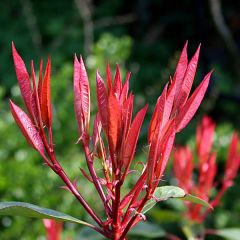
Photinia fraseri Red Robin - Christmas Berry
- Flowering time April to June
- Height at maturity 3 m
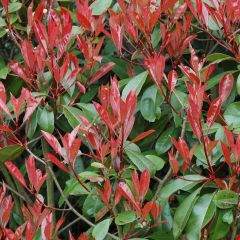
Photinia fraseri Little Red Robin - Christmas Berry
- Flowering time June, July
- Height at maturity 1 m
Our favourite varieties
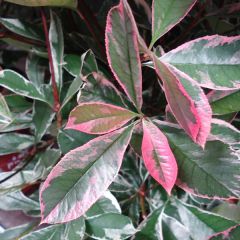
Photinia fraseri Pink Marble - Christmas Berry
- Flowering time May, June
- Height at maturity 3 m
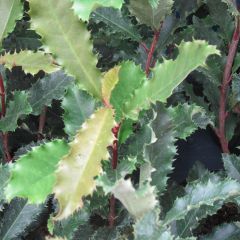
Photinia serratifolia Crunchy
- Flowering time May, June
- Height at maturity 2 m
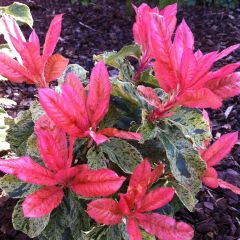
Photinia serratifolia Pink Crispy
- Flowering time May to July
- Height at maturity 1,75 m
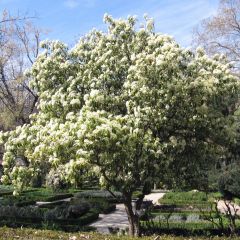
Photinia serratifolia
- Flowering time May to July
- Height at maturity 5 m
Discover other Photinias
View all →Available in 1 sizes
Available in 2 sizes
Available in 3 sizes
Available in 4 sizes
Available in 2 sizes
Available in 2 sizes
Available in 1 sizes
Available in 1 sizes
Available in 1 sizes
Available in 1 sizes
Planting a photinia
Where to plant?
The Photinia x fraseri prefers a light, well-drained, humus-bearing, acidic, neutral or slightly calcareous soil. It particularly dislikes compact clay and overly calcareous soils.
It will thrive in full sun or light shade. A lack of sunlight dulls the young shoots. It is also important to avoid locations exposed to cold, dry winds for this moderately hardy hybrid, tolerant down to -18°C.
The serratifolia species tolerates drought slightly less than fraseri but can withstand waterlogged soils as well as calcareous conditions and sunny or partially shaded exposure. Hardy down to -16°C, its young bronze-pink shoots may suffer from late frosts: choose a sheltered spot from cold, dry winds, such as along a wall. Whenever possible, avoid exposing it to cold winds and prefer an organic mulch at its base. This variety is known to be more robust than Photinia x fraseri against diseases.
When to plant?
Planting is preferably done in autumn to encourage rooting, or in spring. Although it is possible to plant potted photinias at any time of the year, ideally, it is best to do so from October until March or April. Avoid intervening during frost, extreme heat, or when they are flowering.
How to plant?
Photinia are as hardy as they are elegant and they tolerate pruning very well. They can be used in a large free-standing or trimmed hedge, but can also be easily trained into small trees by pruning the lower branches or within a shrub bed. Less vigorous forms like x fraseri ‘Little Red Robin’ or serratifolia ‘Pink Crispy’ tolerate pot cultivation well.
- Moisten the root ball to facilitate recovery.
- Dig a hole that is three times the diameter of the root ball and 30-40 cm deep. Space the plants at least 1 m apart to form a hedge, 3 m for isolated specimens, and 2 m for less vigorous varieties.
- Add compost or organic fertiliser mixed with the backfill soil.
- Position the young plant so as not to bury the collar (the boundary between the roots and the trunk).
- Replace the soil and lightly firm it down.
- Create a basin and pour a good watering can’s worth per plant.
- Spread a layer of mulch at the base to maintain good moisture around the roots. This will also limit the growth of weeds.
For pot cultivation, place a 3-4 cm drainage layer at the bottom of the pot (gravel, broken pottery, etc.). Add a mix consisting of 1/3 soil, 1/3 potting compost, and 1/3 coarse sand.
→ Learn more about growing Photinia in pots and in our tutorial: How to plant a Photinia in the garden?
The maintenance and pruning of photinias
Maintenance
A spring application of well-decomposed compost will be beneficial, improving its growth and making its foliage exceptionally bright.
Photinias are bushes that respond well to pruning; they can also be shaped into topiary forms, such as cones, columns, or balls…
Regular pruning will allow the bush to branch out and produce more colourful juvenile shoots.
Pruning
The pruning of Photinia fraseri ‘Red Robin’ should be done at least twice a year for those planted in hedges: in July, after flowering, and in August-September or after the autumn shoot. This action encourages branching and the growth of new shoots, balances the branches, and reduces them if necessary. Pruning can also be carried out at the end of winter (March), promoting the appearance of colourful leaves, but it may affect spring flowering.
In fact, as the bush tolerates repeated pruning perfectly, it is possible to prune at any time, as soon as the shoots have turned green again, to stimulate regrowth in scarlet tones.
For the dwarf Photinia, an annual pruning is sufficient to maintain a compact habit, preferably carried out in August to avoid harming future flowering.
→ Read also: When and how to prune Photinia?
Diseases and potential pests
Photinia sometimes shows a whitish deposit on the leaves, caused by powdery mildew. Treat the foliage with sulphur; for this, discover our advice sheet dedicated to this disease. The serratifolia species is found to be resistant to this fungus.
It is also very resistant to attacks from the fungus responsible for leaf spot disease and fire blight, unlike other species of Photinia. Although this disease has little impact on the health of the tree, it detracts from its aesthetic appeal. Remove and collect all contaminated leaves, then apply a copper-based treatment in May to the leaves spotted with dark red, to be repeated the following month.
→ Learn more about diseases and pests of Photinia in our advice sheet.
propagation by cuttings
You can propagate Photinia by propagation by cuttings. To do this, cut 15-20 cm long shoots in August-September, then:
- Prepare a pot by filling it with potting mix mixed with sand, or take your cuttings in the ground if it is light, after aerating it with a fork, then moisten the medium.
- Take lateral shoots by pulling them to detach a piece of bark from the parent shoot (heel). They should be healthy and free from diseases.
- Remove the leaves located near the base of the cutting, and trim the others to reduce the leaf surface. Leave only a few leaves at the top if they have not fallen off.
- Make a hole in the medium using a pencil or a wooden stick.
- Place the cutting in the hole and gently firm the soil around it to eliminate air pockets and ensure good contact between the potting mix and the cutting.
- Place the pot under a frame in a warm, bright location but out of direct sunlight.
- Transplant the rooted cuttings in spring into a richer medium and grow them for at least until the following spring before placing the young plants in their final position.
Using and Combining Photinia
Photinia creates stunning monospecific hedges, whether trimmed square or left free, medium or tall depending on the variety used. It is commonly planted alternately with Cherry laurel (Prunus laurocerasus), whose glossy green foliage has roughly the same dimensions. However, you can let your imagination run wild by mixing it with various flowering bushes in spring, such as yellow Forsythia, Japanese quince, Laurus tin, and more. Be inventive!
To achieve a varied hedge that combines splendid foliage, flowers, and colourful berries that will attract wildlife, plant a Pyracantha, an Escallonia, Cherry laurel, Ceanothus, Skimmias, Amelanchiers, Japanese bamboo (Pseudosasa japonica), or other varieties of Photinia. (Be sure to install a rhizome barrier with the bamboo.)
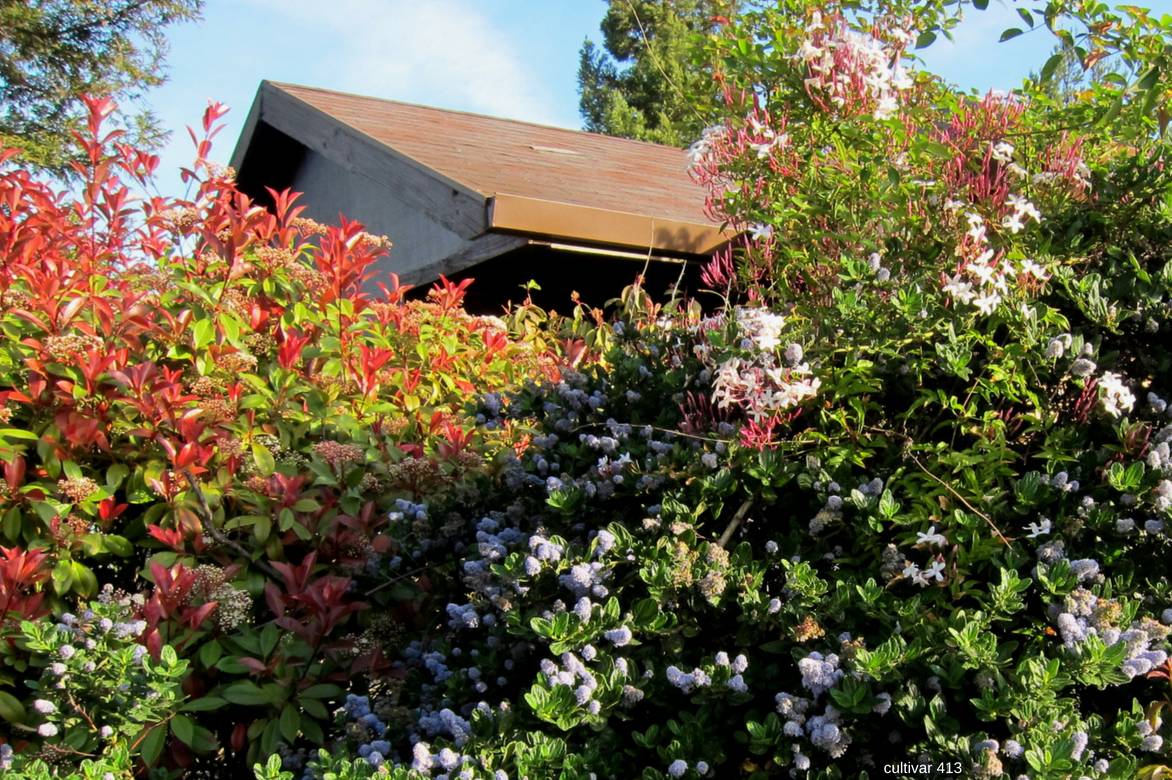
An example of a free hedge combination: Photinia fraseri ‘Red Robin’, Ceanothus arboreus ‘Concha’, Jasminum polyanthum.
Create a baroque flowerbed by mixing variegated foliage with large cream inflorescences: Pseudowintera colorata with yellow-purple tones speckled with bright red, Pieris with colourful shoots accompanied by clusters of bell-shaped flowers, Viburnum sargentii ‘Onondaga’ with its finely cut foliage adorned with flat purple corymbs, and Physocarpus with purple leaves…
Less vigorous forms like Photinia serratifolia Crunchy will undoubtedly add a whimsical touch to a border or container, mixed with the foliage of a modest clematis (Clematis viticella Queen mother, Clematis Blue light, Clematis Josephine) with spring-flowering ground-cover perennials at the base (Geranium sanguineum, Geranium macrorrhizum…) or vibrant colours like Heuchera ‘Tiramisu’ or ‘Peach flambé’.
Photinia, highly suitable for pruning, can also be shaped into topiary, in the form of a cone, column, ball, etc. Plant it as a sentinel to accompany a border of Mahonia media ‘Charity’, which has a very graphic character and spring yellow flowering.
To go further
Discover :
-
- Our wide range of Photinias : it includes classic varieties and others that are more original
- The blog article: Like/Dislike: Photinia ‘Pink Crispy’
- How to propagate Photinia?
- Our advice sheets: How to create a Photinia hedge?, Photinia and drought: what resistance and how to help it in summer? and How to choose the right Photinia for your garden?
- Subscribe!
- Contents
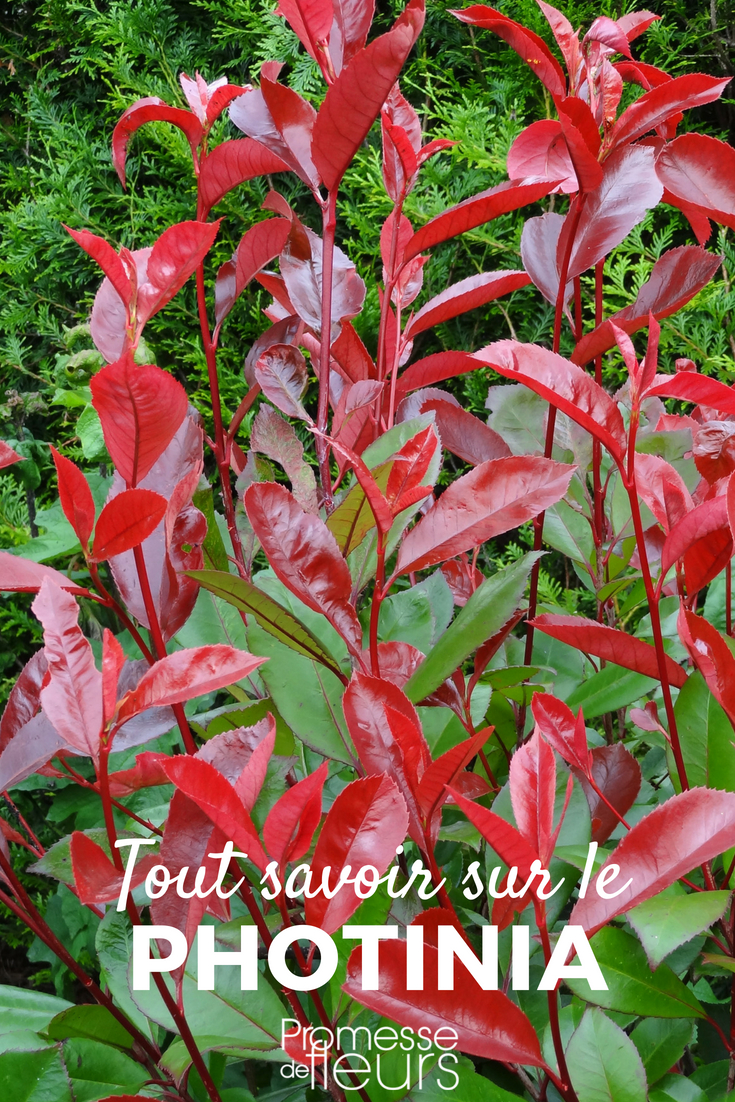































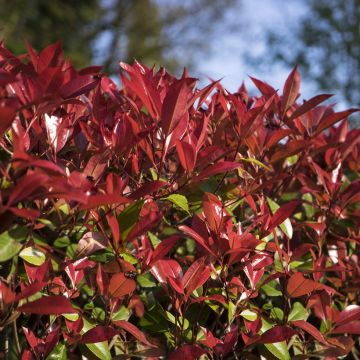
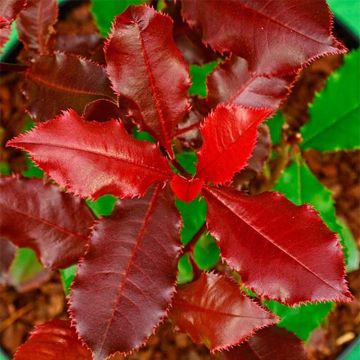


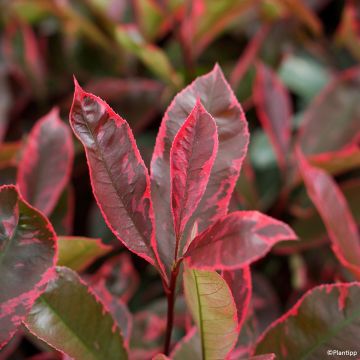
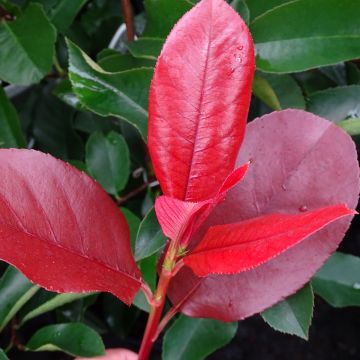
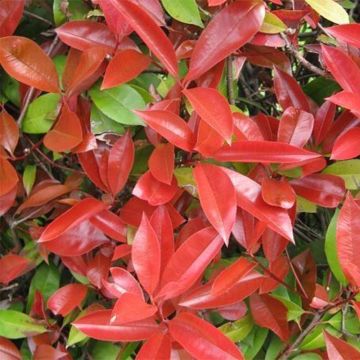

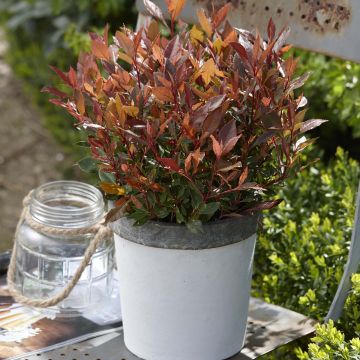
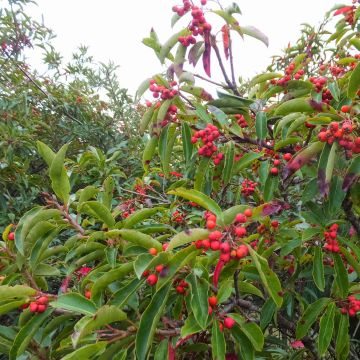
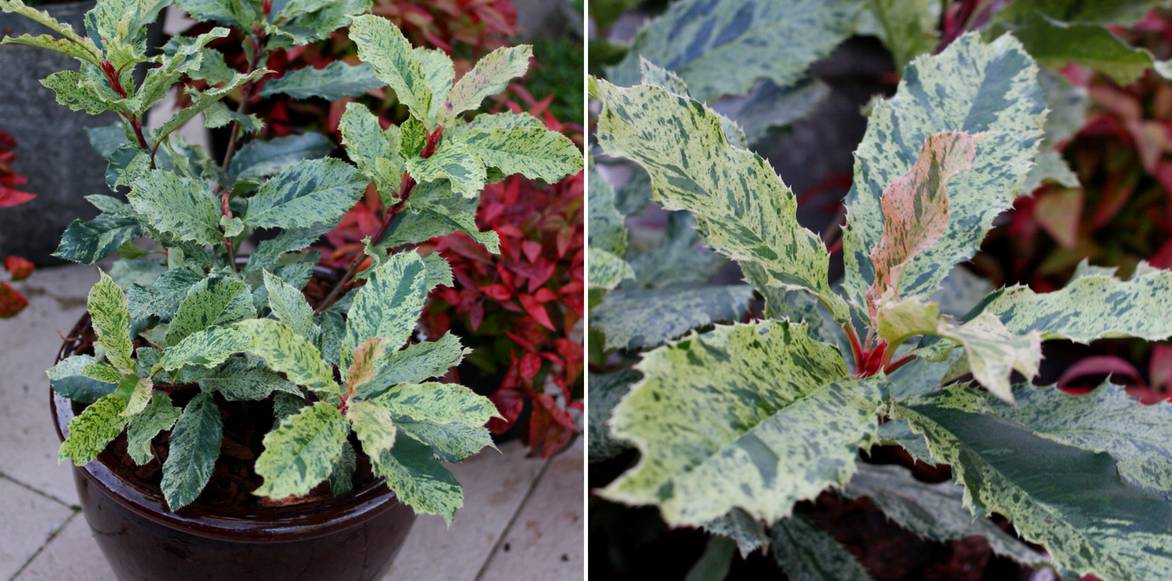
Comments